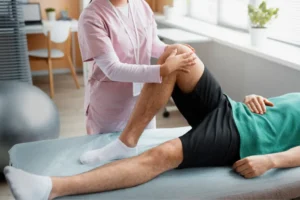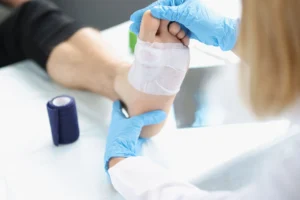Neck pain can be a major disruptor of daily life, making it difficult to perform simple tasks like driving, working, or even sleeping. The good news is that there are effective, non-surgical neck pain treatments available that can provide relief without the need for invasive procedures. From physical therapy to alternative methods like acupuncture and chiropractic care, these options can help manage and even resolve neck pain. In this article, we’ll explore a variety of non-surgical neck pain treatment techniques that have proven to be successful, helping individuals find lasting relief.
Understanding Neck Pain and Its Causes
Neck pain treatment begins with understanding the underlying causes of the pain. Neck pain can stem from various sources, including poor posture, muscle strain, arthritis, or even trauma such as a car accident. The cervical spine (neck area) is delicate, and any disruption to its structure or function can result in significant discomfort. Common causes of neck pain include:
- Muscle strain: Overuse or poor posture often leads to strained muscles in the neck.
- Herniated discs: These can press on nerves and cause intense pain.
- Arthritis: Age-related wear and tear on the spine can lead to chronic neck discomfort.
- Whiplash: A common injury from sudden, forceful neck movement, often from car accidents.
The key to effective neck pain treatment is identifying the cause. Non-surgical approaches can provide relief and improve mobility without the need for invasive surgeries that may carry greater risks. An Osteopractic Physical Therapist in Central Indiana can help determine the root cause of your neck pain and design a customized treatment plan for relief.
Benefits of Non-Surgical Neck Pain Treatments
When it comes to managing neck pain, non-surgical treatments offer several benefits over more invasive options. For many individuals, these treatments provide relief without the need for long recovery times, hospital stays, or the risks associated with surgery. Some key benefits of non-surgical neck pain treatments include:
- Minimal recovery time: Non-surgical treatments typically require less downtime, allowing you to return to your normal activities more quickly.
- Fewer risks: Surgery always carries risks such as infection, nerve damage, and long-term complications. Non-surgical methods are generally safer.
- Cost-effectiveness: Non-invasive treatments like physical therapy, chiropractic care, and massage are often less expensive than surgery.
- Holistic approach: These treatments often address multiple factors contributing to the pain, including muscle imbalances, posture, and stress.
By focusing on non-surgical neck pain treatments, individuals can achieve relief in a safer and more sustainable way, without having to worry about the potential complications that come with surgery.
Effective Non-Surgical Treatments for Neck Pain
Several non-surgical neck pain treatments have proven to be effective in managing and alleviating pain. Let’s take a closer look at some of the most widely used and beneficial options.
Physical Therapy
Physical therapy is one of the most effective neck pain treatments available. An osteopractic physical therapist can develop a personalized program of exercises designed to strengthen the muscles around the neck and improve posture. These exercises help reduce strain on the cervical spine and prevent future injuries.
The neck pain treatment process through physical therapy typically includes stretching and strengthening exercises, posture training, and manual therapy to mobilize the joints. Over time, these exercises can help reduce pain and improve flexibility and strength, leading to long-term relief.
Chiropractic Care
Chiropractic care, particularly spinal manipulation, is another highly effective neck pain treatment. Chiropractors use gentle adjustments to realign the vertebrae in the neck, improving spinal function and reducing pain. This type of therapy can be particularly beneficial for individuals dealing with issues like herniated discs or poor posture.
Chiropractic adjustments can restore the proper alignment of the cervical spine, which not only alleviates pain but also prevents it from recurring. This is a non-invasive and highly effective neck pain treatment that can offer immediate relief.
Massage Therapy
Massage therapy is an excellent neck pain treatment that can help reduce tension in the muscles of the neck and shoulders. Deep tissue massage, trigger point therapy, and myofascial release are all effective techniques used to target muscle knots and improve blood flow to the area, promoting healing and relieving pain.
Regular massage therapy sessions can help reduce chronic neck pain, increase flexibility, and improve overall function in the neck muscles. This hands-on approach is often used in conjunction with other treatments, such as physical therapy, to provide comprehensive neck pain treatment.
Acupuncture
Acupuncture is a traditional Chinese medicine technique that has gained popularity in Western medicine as a non-surgical neck pain treatment. It involves inserting thin needles into specific points on the body to stimulate the nervous system and promote healing. For neck pain, acupuncture targets pain pathways and helps reduce inflammation, improving overall function and mobility.
Research has shown that acupuncture can be highly effective for neck pain relief, especially when combined with other treatments like physical therapy. This non-invasive approach can help reduce the intensity of pain and promote long-term healing without the need for surgery.
Hot and Cold Therapy
Using hot and cold therapy is a simple yet effective neck pain treatment. Cold therapy helps reduce inflammation and numb the area, while heat therapy promotes blood circulation and relaxes muscles. Both therapies can provide quick relief from acute neck pain and muscle stiffness.
Alternating between hot and cold packs can significantly reduce the intensity of neck pain, especially when used after physical therapy or chiropractic adjustments. This combination of at-home neck pain treatments is a cost-effective and easy way to manage discomfort.
At-Home Remedies and Lifestyle Changes
In addition to professional treatments, there are several at-home remedies and lifestyle changes that can complement neck pain treatment and prevent future issues. Here are a few simple strategies:
- Posture correction: Poor posture, especially from prolonged sitting at a desk, is one of the leading causes of neck pain. Regularly checking your posture and ensuring that your workstation is ergonomically set up can help prevent pain.
- Neck exercises: Incorporating simple neck stretches and exercises into your daily routine can help strengthen the muscles and improve flexibility, reducing the likelihood of neck pain.
- Proper sleep position: Sleeping in a position that supports the natural curvature of your neck is essential for reducing pain. Consider using a cervical pillow to support your neck while you sleep.
- Ergonomic adjustments: Ensure your work environment is set up to minimize strain on your neck and back. This may include adjusting the height of your desk or computer monitor and taking regular breaks to stretch.
These lifestyle changes, combined with professional neck pain treatments, can provide lasting relief and reduce the likelihood of future pain.
When to Seek Professional Help
While most cases of neck pain can be managed with non-surgical treatments, there are times when professional help is necessary. If you experience persistent neck pain that does not improve with at-home remedies or over-the-counter medications, or if you notice symptoms like tingling, numbness, or weakness in your arms or hands, it may be time to seek professional help.
An Osteopractic Physical Therapist in Central Indiana can conduct a thorough evaluation to determine the root cause of your neck pain and recommend the appropriate course of treatment. In cases of severe neck pain or injury, seeking timely professional care can prevent further complications and speed up recovery.
Combining Treatments for Better Results
For optimal results, many people benefit from combining different non-surgical neck pain treatments. For example, physical therapy can strengthen the muscles, while chiropractic care realigns the spine, and massage therapy targets tight muscles. When these treatments are used together, they offer a comprehensive approach to pain relief and recovery.
Working with a healthcare provider who specializes in neck pain treatment can help you develop a multimodal treatment plan that addresses all aspects of your pain. This integrated approach often leads to faster recovery and more sustainable relief.
Takeaway
Non-surgical neck pain treatments offer a variety of options for individuals looking to manage and reduce their neck pain. From physical therapy and chiropractic care to acupuncture and hot/cold therapy, there are numerous techniques that can provide effective relief. By understanding the causes of your neck pain and consulting with a professional, such as an Osteopractic Physical Therapist in Central Indiana, you can find a treatment plan that works for you. Start taking action today and explore the many non-invasive treatments that can help you achieve lasting relief from neck pain.
FAQs
1. How long does it take for non-surgical treatments to relieve neck pain?
The length of time required to see improvement depends on the severity of the neck pain and the treatment used. Many individuals experience relief within a few weeks of starting physical therapy or chiropractic care.
2. Can neck pain be cured without surgery?
Yes, many cases of neck pain can be effectively treated without surgery using non-surgical treatments such as physical therapy, massage therapy, chiropractic care, and acupuncture.
3. What is the most effective treatment for chronic neck pain?
The most effective treatment for chronic neck pain often involves a combination of therapies, such as physical therapy for strengthening and stretching, chiropractic care for spinal alignment, and massage therapy for muscle relaxation.











